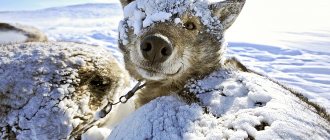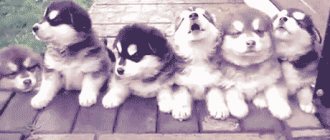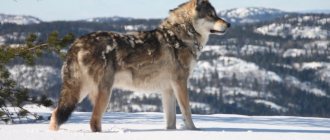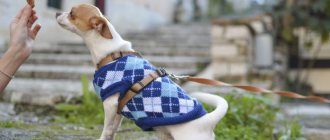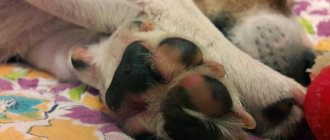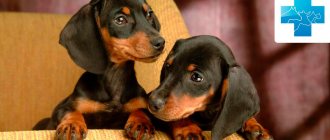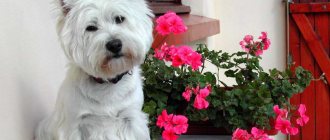With the onset of winter, many German Shepherd owners wonder whether dogs can spend the winter outside or whether they should move their pet indoors for the entire winter period. How do animals of this breed tolerate cold, at what temperature can a German Shepherd live outside, and what nuances should be taken into account when keeping a pet in an open enclosure in winter?
Dogs for street keeping: list of breeds
In fact, the opinion that a dog can live outside all year round and is not afraid of the cold is wrong. A dog also needs warmth, good nutrition and comfort. Therefore, you will have to take care of a warm booth. Puppies need a lot of attention. Unlike adult dogs, they require more attention. There is a risk of frostbite in very low temperatures.
List of breeds for keeping outside:
- Alobai
- Foxound
- Rottweiler
- Bobtail
- Collie
- German Shepherd
Golden retrievers are all the rage right now. In fact, this dog is not entirely suitable for guarding and being constantly on the street.
Dogs for street keeping: list of breeds
General criteria
Since the animal will spend a lot of time outside, it needs a powerful undercoat to protect it from winter cold, endurance, strength and high learning abilities.
General rules for choosing a dog for a private home:
- You should not have hunting dogs. Friendliness will not allow them to become reliable guards, and their hunting instinct will be a threat to other pets.
- Fighting breeds are bred specifically for fighting. It is dangerous to develop the aggression necessary for protection in them, so they are also not suitable.
- Rescue dogs such as the Labrador or Newfoundland, despite their intimidating size, are very friendly. You can have them if there are small children in the family. They will become loyal friends and protectors, but are unlikely to be ferocious guards over a vast territory.
It is important to determine the size and gender of the animal. Large dogs require more attention. They need regular physical activity and training to tame their temper and teach them to obey all the owner’s commands. The bitch is easier to train, she has a gentle character. The male dog is more stubborn and needs more rigorous training.
Below are dog breeds that were specifically created to serve as guard dogs.
How to properly care?
Caring for a German Shepherd involves different activities.
Hygiene:
- combing;
- bathing;
- nail trimming;
- ear cleaning.
Mandatory visits to the veterinary clinic for periodic examinations and vaccinations ensure that the animal avoids diseases.
Regular long walks at least twice a day for an adult dog and more frequent for puppies and adolescents will ensure the physical strength and mental health of the pet.
Training is an obligatory stage in keeping a German Shepherd : a visit to the site and classes with an instructor is recommended, but raising the puppy independently is also allowed if the owner already has the appropriate skills and experience in handling serious service breeds.
A well-mannered, well-groomed dog will never cause problems for its owner. But in order for the German Shepherd to be obedient and healthy, the owner will have to put in a lot of effort and be patient. And then a harmonious tandem of man and dog will form, and life will be filled with mutual love and trust, devotion on the part of the pet and adoration for the four-legged friend on the part of the owner.
Owner's character
Evaluate yourself as a person. Active athletes and quiet housewives need different dog breeds. There are a number of breeds known that only strong and strong-willed people can handle. Popular decorative breeds will require a lot of time and attention, and are capable of causing scenes of jealousy if someone decides to get closer to their beloved owner or mistress.
If a person has a high degree of activity and is considered a follower of an active healthy lifestyle - he likes cycling, jogging, rollerblading, an active, agile and nimble representative of the dog breed will be suitable. For example, Irish Setter, Husky, Greyhound Italian Greyhound.
Let the calm and balanced future owner take a closer look at retrievers or pugs. Business active people with a strong-willed character can purchase a German Shepherd, Doberman or Rottweiler.
If you are thinking about purchasing a decorative breed, remember that indoor pets require significant attention. Capable of being stubborn, extremely nervous and sensitive.
Most dog trainers and breeders recommend adopting a small puppy. Obvious difficulties with raising and raising are foreseen, but there is firm confidence in the upbringing and disposition of the pet. Some people prefer to adopt an adult dog to avoid the hassles of growing up, hassling with vaccinations, and childhood diseases.
Dog breeds for keeping in an enclosure: list
These are guard dogs that look after the area. In addition, such dogs should be great with children. Many people pay attention to this because they have children. The dog must be patient with children and the elderly. It is also worth considering that in winter the temperature can be very low.
The enclosure should have a booth and be spacious enough. Some breeds, despite their resistance to low temperatures, love to run, so keeping them in an enclosure is not very suitable for them. It is also worth considering that some of the breeds require constant movement.
List of breeds:
- Australian Shepherd
- Alaskan Malamute
- Alabai
- Swiss Shepherd
- Bobtail
- Grosser
- German Shepherd
Dog breeds for keeping in an enclosure: list
What's inside
It has been experimentally established that the best bedding for dogs in winter is hay. It will either have to be prepared in the summer and stored in a ventilated, dry area, or purchased. There should be enough hay so that the dog can build some kind of nest there.
If there is too much bedding, the hay will constantly fall out, and if there is too little hay, the dog will not warm up. The bedding can usually fall out every time the dog leaves the kennel. To prevent this, you need to nail a threshold in front of the entrance.
Spine
Special contents of the dachshund
only the lanky one requires. Sometimes even a load that is insignificant for other dogs can cause a prolapsed intervertebral disc or hernia in a dachshund. Therefore, it is extremely important to take precautions: do not allow them to jump, avoid steps and stairs, never lift them by the scruff of the neck, do not allow puppies to stand on their hind legs even in play.
Quality walks are the best answer to the question of how to care for a dachshund in an apartment.
To keep muscles in good shape, it is necessary to exercise them longer and more often. This is also a prevention of spinal diseases.
Dog breeds for keeping outside in a kennel: list
Despite the fact that the dog will live in a booth, it is worth taking care of normal conditions. In winter, the temperature can drop quite low, so it is worth insulating the booth.
Booth requirements:
- Removable roof. This is necessary so that you can properly clean the inside of the dog’s house. Then make sure that the joints between the walls and the roof are airtight. This will prevent water from flowing in during rain. The roof should not be straight, but be inclined. This will ensure rapid drainage of water and snow.
- Insulated walls. It could be polystyrene foam. It perfectly retains heat inside the booth and does not heat up much when exposed to sunlight. Some dogs can chew foam, so you can line the inside of the house with a sheet of USB. The dog will be warm and cozy.
- Sufficient size . The size of the booth should be such that the dog inside it can stand up, sit and turn around normally. At the same time, you should not make a huge booth, since in winter the dog will freeze in it.
- Material. It is best to make a booth from plastic or wood. These materials do not heat up and are easy to clean.
- Entrance. It is best to make the entrance not in the middle, but from the side. This will allow the dog to hide from the wind. In this case, the entrance can be covered with a layer of felt. It is secured at the top and hangs over like a curtain. The dog can easily enter the kennel, but it is also warm and cozy in the winter.
- Floor. It must be made of boards. In this case, it is best to place the booth on legs. In this case, it will not contact the ground. There will be an air cushion between the floor and the ground. Do not cover the floor with a cotton blanket. When wet, it takes a long time to dry and can begin to rot. In addition, many dogs deliberately take all the trash outside the booth. The most interesting thing is that almost none of the pets throw hay out of the kennel.
Dog breeds for keeping outside in a kennel: list Dog breeds for keeping in a kennel:
- German Shepherd
- Rottweiler
- Asian
- Caucasian
- Husky
- Samoyed
- Laika
- Malamute
Dog breeds for keeping outside in a kennel: list
Should you keep your husky on a chain?
No! Laika cannot be kept on a chain . No companion dog should be kept on a chain. This violates the animal's right to freedom, constantly reminding him that he is chained to a booth.
Confinement in chains is only acceptable for working guard dogs trained to ward off strangers (and attack if necessary). From childhood, a service guard dog is taught not only distrust, but also anger towards strangers, the ability to attack a stranger when invading a protected territory. These skills are difficult for a hunting dog to learn. The Laika is a breed oriented towards cooperation with humans, affectionate and in need of communication. Trying to raise a husky to be an evil guard is unlikely to yield results:
- this is psychological violence against a dog that is not characterized by aggressive behavior;
- the husky will not be able to fully guard the house due to its small size (the average height at the withers of the West Siberian husky is only 60 cm).
We will not discuss how humane it is to keep chained dogs in general. They lived, live and, apparently, will live on a chain for many more decades. Let's talk about those dogs that we ourselves have chosen as friends, and about the conditions that need to be created so that they live in comfort and feel loved.
Buying a little friend
If you are interested in how much a Dachshund puppy costs, then on our website you will find a section with prices.
The cost of a dog varies depending on external circumstances.
Our dachshund breeding nursery individually prepares the animal for communication with humans, providing professional care for our smaller brothers.
Our breeders are able not only to give vaccinations, but also to cultivate a long nose, satisfying his boundless curiosity.
Summing up
Conventionally, known breeds are divided into 4 groups, determined in connection with the main purposes of the representatives included in each group of breeds. Guard breeds are popular and in demand today. Representatives of the hunting group are no less popular. When choosing a breed, try to evaluate your own nature in an extremely honest way, then it will be much easier to choose.
For example, a lazy or overly busy person at work is clearly not suitable for an overactive pet that requires an active lifestyle. A small decorative puppy will not tolerate hard, energetic training. A person with a gentle character will not need to have a representative of the fighting breed. Dogs sense the slightest weakness of the owner and use the mistake to their own advantage. Representatives of service breeds are also not ideal for a gentle person, requiring strictness.
A dog is a man’s friend and often reflects the essence of its owner. Try to choose a pet that matches your own character. Then it will be much easier to find a common language with the animal.
In order not to be mistaken about which dog is best to bring into a private home, you need to carefully study the breeds and determine what exactly a four-legged friend is needed for. Most often it is purchased for protection.
What temperature can dogs withstand outside in winter?
It all depends on the breed of the dog and how you trained it. The most interesting thing is that during severe frosts you should not take the dog from the street into the house. This is fraught with molting. In addition, temperature changes make dogs sick. A good owner should be concerned about the dog's health.
List of procedures for severe frosts:
- Improve your pet's diet. At this time, it is necessary to increase the amount of food, since energy costs are quite high. Introduce more proteins and carbohydrates into your diet. Be sure to give your dog plenty of water.
- Insulate the booth. To do this, you need to make sure that the dog’s house does not leak and retains heat well. After this, spread a high cushion of hay.
- Increase the walk time of the pass. If he is in an enclosure, he should let the dog out to run more often. This improves blood circulation and helps keep the dog warm.
- It is worth noting that absolutely healthy pets tolerate cold better. If your dog has arthritis, you should take care of him.
- Vitamins. At this time, give your pets special vitamin complexes. They will improve food absorption and keep the dog healthy.
In general, for breeds such as husky and Asian shepherd, the permissible temperature is -40 °C. These breeds tolerate cold better than heat. Therefore, if you take your pet into the house, it will begin to shed. Thus, the dog gets rid of the undercoat in order to cool the body a little. After this, the dog cannot be kept on the street, otherwise diseases cannot be avoided.
What temperature can dogs withstand outside in winter? As you can see, some breeds benefit from cold weather rather than hot weather. Dogs such as huskies, collies and grossers are not afraid of snow and tolerate frost well. They feel fine in enclosures and booths even during severe frosts.
Aviary size
Unlike a booth, the bigger the better. Especially if the dog will spend a lot of time in it. In any case, no less than 3*5 m.
Don’t make it too high - there will be more precipitation, but don’t make it too low - it’s uncomfortable for you and there won’t be enough light, stuffy in the heat. A height of 2.0-2.5 m in the front, with a slope towards the rear wall, a height of 1.7-1.8 m, is quite enough.
Blind walls can be made of brick, cinder block, metal profiles, wood.
The grille at the front should be reliable and have a small cell. At no age should a dog be able to stick its head through the net and get stuck.
It is very convenient to have a feeder in the mesh of the enclosure, in which you can put a bowl of food and water without entering the enclosure. In this case, the dog will not knock the bowl out of your hands, and in the event of your absence, any person will be able to feed and water it. A detailed guide on the nutrition of German Shepherds.
The door to the enclosure should open inward. Then, if a person comes in and the dog jumps on it, the door will close, but the dog still won’t be able to get out without the person’s consent.
It is more convenient to place the light switch outside and as high as possible so that the dog does not become interested in it and it does not start gnawing on it. Some install a switch under the roof of the enclosure, if the height does not exceed 2 meters, some - simply at face level or slightly higher. Actually, if the switch is located on the blank wall of the enclosure from the outside, then the height of the face level of a person of average height will be enough.
The enclosure may have a winter road (a closed, insulated room with or without a window) and a walk without a roof adjacent to the enclosure.
The winter road is intended for a bitch with puppies to stay in during particularly uncomfortable weather conditions. It can be heated or equipped to ensure maximum maintenance of a comfortable temperature.
A small entrance with an opening/closing door is made into the door to the winter road from below. A standard door is designed for people who will enter for cleaning or other needs. A small door is for the dog. Let's say, if you want the animal to stay only in the winter road for some time, you close this door. When the dog needs to move around the entire enclosure, open it.
The latch on the door of the enclosure should be reliable and - better - with locking hinges, since some particularly cunning and dexterous dogs can easily move the latch and go out themselves or let their relatives out. Males are especially inventive when hunting from a bitch in heat that interests them. During this period, it is better to lock the enclosure.
Place the booth in the enclosure in such a way as to prevent precipitation and wind from entering it.
Feeding and diet
Dachshunds do not eat a lot - based on the calculation of 40 g of food per 1 kg of dog weight , the serving size should be on average 120-315 g .
Natural products and ready-made industrial feeds are suitable for feeding, but both types of food should not be mixed.
With a natural diet, the dog’s menu should include:
- lean meat;
- fish, but maximum 2 times a week;
- rice, buckwheat, rolled oats and wheat cereals;
- pasta, but infrequently and only from durum wheat;
- dairy products;
- boiled eggs, preferably only the yolk;
- vegetables and fruits, except grapes;
- biscuits, unleavened crackers.
Food should be warm, cooked without adding salt or spices. In addition, the natural diet must be supplemented with vitamin and mineral complexes.
Dachshunds are not allowed to give:
- pork;
- sweets and confectionery;
- bones;
- sausages and smoked meats;
- pickles, marinades;
- fatty dairy products;
- semolina and pearl barley.
When feeding with industrial feeds, preference should be given to premium and super-premium products or holistic feeds. The best dry food for this breed: Royal Canin, Brit Care, Acana, Almo Nature, Arden Grange.
Proper care for your dachshund
Proper care of an animal is not only the correct diet, but also proper care for the condition of the body.
There are plenty of nuances here, and future lovers of this breed should know them.
Ear and eye care
The eyes of this dog are protected by nature, namely by the structure of the muzzle. Thanks to their special shape, the animal’s eyes are to some extent protected from dust and small debris. But this should not be a reason for a complete lack of care for this part of the body. Like other dogs, they can get into various situations while playing on walks that can affect the quality of their vision, and these problems should not be allowed in dachshunds. Eye care tips:
- A tearful secretion may collect in the corners of the dog's eyes, from which the eyes need to be cleaned periodically. Remove it with a damp soft cloth.
- Dachshunds' eyes may water excessively. To prevent this phenomenon or reduce it, the animal needs to wash its eyes with a 2% solution of boric acid or brew tea (not green, but black).
- If the tearfulness does not decrease or stop after 3 days of treatment, the dachshund should be taken to the veterinarian.
The animal’s ears also need care; they should be periodically cleaned of street dirt and sulfur clots.
Clean with a cotton swab, using cleaning products: “Polyseptin”, “Otoferonol”, “Bars”
. You need to clean your ears only within sight, so as not to harm the eardrum, after first dropping a few drops of cleaning solution into the auricle.
Dachshund coat care
This breed of dog does not require special coat care. Regular washing and brushing is the optimal set of measures.
You can bathe the animal itself no more than once every 2 months. And after a walk, wipe your dog’s paws with a damp cloth. This applies to smooth-haired breeds. During shedding, you need to brush a little more often to prevent clumps of fur from forming.
Dachshunds with long hair require longer and more frequent brushing.
Be sure to do this after a walk to remove tangled grass and other debris from your body.
You need to keep in mind that dachshunds do not like to be groomed,
therefore, the owner will need to regularly reward her with treats or walks.
Dental care
Most health problems in dogs occur due to dental damage.
The peculiarities of this breed are the knowledge of the world and everything around it through its mouth. They always have to chew on something, and this often ruins their teeth. You need to brush your teeth as often as possible using a toothbrush.
It is strictly forbidden to use toothpastes.
It is better to do this with saline solution. The animal also does not like this procedure, so at first it is impossible to do without outside help.
Paw care
Some dachshund owners consider caring for their nails and toenail hair overkill.
Too long claws on the paws, especially in small individuals, cause lameness. Long hair between them also interferes with the dog's walking. To prevent these sad phenomena, both the claws and the hair on the paws need to be trimmed periodically.
You can buy a nail clipper at any pet store. With its help, it will be easier to trim the strong nail plate on the dachshund's paws. They need to be trimmed at least once every 2 months.
Hypothermia
The domestic dog's body does not tolerate prolonged exposure to low temperatures. This is especially true for animals with short hair that do not have a dense undercoat. Prolonged exposure to cold reduces the pet's immunity and provokes the development of diseases. Dogs with thick and long hair suffer less from frost.
In winter, you should reduce your walking time. Dwarf dogs that have scanty hair are better off staying indoors in cold weather. Prepare a toilet for the animal so that it can cope with its physiological needs. Veterinarians do not recommend shaving or trimming a dog's fur during the cold season. You should not deprive your pet of natural protection from frost.
Preparations for disinfestation of dog kennels and enclosures
The AVZ catalog presents the products necessary for treating dogs’ habitats and protecting animals from fleas, ticks and other ectoparasites.
- "Deltsid", emulsion concentrate
. Available in ampoules, economical. The drug is intended for the fight against ectoparasites of animals, disinsection, and decontamination of enclosures. - "Bars Forte" for dogs
. This is a spray for insectoacaricidal treatment of pets and their habitats. Available in 100 ml bottles with a sprayer. - Insectoacaricidal spray "Bars" for dogs.
It is also a medicine for arachnoenthomosis. Available in 100 and 200 ml bottles with a sprayer.
When using medications, follow the instructions in the instructions.
Cleaning and disinfection
Feces and garbage are removed from the area daily. The floor is swept twice a week. The booth is cleaned monthly. The litter is washed and treated for parasites, the straw is completely replaced. Disinfection is carried out quarterly in spring, autumn and winter, and monthly in summer. After treatment, the animal should not enter the area until the surfaces are completely ventilated and dry.
Do I need to bathe?
Until the dog is 5 months old, it cannot be bathed - at this time it is still undergoing the necessary vaccinations. In case of emergency, you can rinse your pet under warm running water; this should be done after every walk.
In the future, you need to bathe the dog in the bathtub, placing a rubber mat on the bottom so that the paws do not slip..
For washing, you need to use special shampoos that match the type of dachshund’s coat.
CAREFULLY!
Washing too frequently dries out your pet's skin and deteriorates the quality of the coat, so you should bathe your dachshund no more than once a quarter.
What does it cost to drink?
Clean filtered drinking water is exactly what your pet needs. It is possible to give boiled water.
Some owners ask, is it possible to give a dog milk? If the pet tolerates such a product normally and does not have digestive problems, then giving the pet milk is sometimes allowed, but this will not replace water. Let us note that many experts believe that it is better not to take risks, because milk in its pure form is often poorly digested, which negatively affects the well-being of the pet.
Strongly mineral water is contraindicated for pets; it can be given unless there is no other way to give the dog something to drink. It is first necessary to open the lid and release the gas bubbles. And of course, you should not allow your animal to drink from stagnant ponds and puddles; too many harmful microorganisms also accumulate there.
Carbonated and sweet water is not acceptable for dogs.
Tap water is also suitable if you are sure of its purity. But if you yourself don’t risk drinking it from there, then you shouldn’t offer it to your pet.
Nail trimming
Due to too long nails, the dog cannot fully step on its paws, which leads to improper distribution of the load on the ligaments and joints, causing lameness.
In adults leading an active lifestyle, the claws wear down on their own during long walks..
If this does not happen, the nails should be trimmed using a guillotine nail clipper at least once a month, carefully shortening the nail plate so as not to touch the blood vessels.
Limb injuries
In winter, you need to pay special attention to the paw pads. They can be injured by ice cover and sharp objects that lie under the snow (shards of glass, pieces of reinforcement, stones and nails). Snow clogs the space between the toes and begins to melt slightly. After this he is caught in the cold. Ice crystals form on the paws, injuring the skin.
The dog begins to limp, clutch its frozen limb and show signs of anxiety. Severe frostbite of the skin leads to the formation of blisters on the skin. Prolonged exposure to low temperatures provokes the development of tissue necrosis and gangrene. If the animal does not undergo urgent surgery, it will die.
During the cold season, the dog’s limbs are exposed to chemical reagents and deicing mixtures. Aggressive substances injure the skin. Reagents may cause an allergic reaction in the dog. This problem is especially relevant at the end of winter, when the snow begins to melt. Chemicals accumulated over the winter turn into fine dust. It enters the animal's respiratory tract, causing severe irritation and swelling.
During active winter games, the dog can break, sprain or dislocate its paw. A sprain occurs due to poor grip of the paw and the surface of the ground. During the cold season, tendons become less elastic and are easily injured. Serious injuries cannot be treated on your own. Only a doctor can correctly perform surgery and correctly apply a plaster cast to the damaged limb.
Wool protects dogs from the cold
Wire-haired, short-haired, long-haired dogs with thick undercoat do not freeze in winter. Of course, if we consider the effect of low temperatures up to a certain point. For example, Caucasian Shepherd Dogs are able to tolerate air temperatures down to -40 degrees; it is reasonable to assume that a significant decrease in air temperature will be fatal for the animals. If we talk about northern breeds, for example, Husky, other cold-resistant breeds, such as Moscow Watchdog, Leonberger, Bernese Mountain Dog, then they would prefer to live outside in winter, sleep in the snow, feeling comfortable, rather than spend winter nights indoors where they will suffer from the heat.
Do not forget that representatives of the same breed tolerate cold differently. So dogs living in apartment conditions freeze faster, even if they have thick hair. Pets living in an apartment stay warm most of the time, and the characteristics of the body are such that animals shed in warmth. The undercoat falls out as unnecessary and it is more difficult for such animals to endure the cold.
By winter, dogs build up a thick undercoat, which ensures heat retention, but to a greater extent, heat retention is influenced not by the thick coat, but by the size of the animal. It is known that large breeds lose heat more slowly, while small breed dogs begin to feel cold after a short stay in the cold. Pets without undercoat, with insufficiently developed undercoat (poodles) or without any fur at all (xoloitzcuintle) need winter clothing that helps retain heat and warm the animal's body.
Miniature Schnauzer
Intelligence, attentiveness, ideal endurance - this is the psychological portrait of the smallest (only 4-8 kg) dog of a service breed called a miniature schnauzer. This is a fearless and vigilant guard, ready to defend the territory, home, and owner to the end.
A cheerful disposition and agility harmoniously complement a balanced character, which makes the miniature not only an ideal guard, but also a cheerful companion for active games.
Do you want a bigger dog? Read these articles:
Dogs for site protection: the best large and medium breeds
Dogs for land protection: the best giant breeds
Do you want a dog that will catch rats? See here:
Dogs that catch rats and mice no worse than cats (the most catching breeds)
Are you choosing a guard among the mongrel puppies? Here:
Outbred puppy: how to understand what size it will grow?
Future companion, guard or hunter? How to determine the character of a mongrel puppy
Helpful Tips:
A dog for guarding an area: what it should be, the difference between guard and security, the best breeds
When choosing a dog for a private home, you must first decide on the purpose. Any domestic breed is suitable as a companion dog that will spend most of its time in a warm house by the fireplace next to its owner. To protect the home, property and owners, it is important that the dog has security and guard potential. A dog that will live in an enclosure or roam freely around the site must tolerate frost well and be in good health.
Criterias of choice . Any breed that has the following characteristics is suitable for keeping outdoors:
- strong physique;
- endurance;
- independence;
easy learning ability; - mobility.
To live permanently outside in harsh winter conditions, the pet must have a thick undercoat. On the contrary, if the house is located in the southern zone, it is better that the wool does not create a greenhouse effect. Huskies, Alabai, Tibetan Mastiff and other frost-resistant breeds do not tolerate heat well. For dogs with short hair, it is better to equip a warm kennel or let them spend the winter in the house.
Guard breeds . If you want your dog to perform the duties of a protector and guard, you should pay attention to breeds with security and watchdog potential. These are usually medium or large breeds with well-developed muscles and a wide head. Despite their physical strength, these dogs are obedient and devoted to their owner. They adore their family, so they will not offend anyone and will protect their territory and property from strangers.
The following have good guard qualities:
- Cane Corso;
- Moscow watchdog;
- Caucasian Shepherd Dog;
- Tibetan mastiff;
- alabai;
- Russian black terrier;
- East European Shepherd;
- Leonberger.
It is important to raise a dog so that it feels responsible for the family and property, but does not consider itself the leader of the pack. Otherwise, the owners themselves may be among the “strangers.”
Companion dogs for outdoor living . If home security is not the main purpose of buying a dog, you should pay attention to large, active dogs that will be more comfortable on the street than in a cramped room. Their security and guard qualities are weakly expressed. But these pets will be happy to walk, play in the area and raise their voices when strangers approach.
The following are suitable as a companion dog on the site:
- Newfoundland;
- Saint Bernard;
- Bernese Mountain Dog;
- Border Collie;
- Labrador;
- Aussie;
- Golden retriever;
- husky;
- malamute
Newfies and St. Bernards will make excellent nannies for children. You can play with a border collie or labrador in the area and go for walks to the lake or in the forest. It is better not to keep hunters, for example, dachshunds, spaniels, huskies, greyhounds, on the property, especially if you are going to grow crops and breed birds. Due to their hunting instincts, pets can dig up the entire garden and strangle a couple of chickens.
Features of the content . For a dog on the street, it is imperative to build a strong booth that will protect the pet from bad weather, heat and frost. If winter lasts a long time and the temperature stays below zero, it is better to insulate the dog house. The booth should be roomy, according to the size of the dog. Ideally, the pet can stretch out, stand up, and hide in the far corner.
It is advisable that the booth opens into the enclosure. This is where the dog will eat, drink and breathe air. Enclosures are needed if the dog is trying to protect property from everyone, including invited guests. In addition, the fence will prevent escapes from the site.
A dog living on the street must be regularly treated for parasites. All required vaccinations are required. Periodically comb and wash your pet to remove dust and sand stuck in the fur.
Editorial opinion may not reflect the views of the author.
Did you like the article? Tell your friends about it!
Dogs living outside in a kennel or enclosure have a hard time in winter. Especially in areas where the thermometer drops quite low. How to insulate a home for a four-legged friend so that he can survive the cold without any problems - this question interests many owners.
How to set up a place for a dachshund
To care for your dachshund at home, choose a place for it to rest. To do this, you can follow the following rules:
- You cannot arrange a place in a place that is inconvenient for you: in the kitchen, in the bathroom, in the corridor or hallway. The dog will get in the way or get cold in drafts;
- the best place in the house is a corner in the room, where it is quite cozy and has a good view;
- you can buy a house or bedding;
- the house must be very strong, otherwise the puppy will simply chew it up;
- the bedding should be covered with oilcloth; you can put a padding polyester blanket on top;
- in both cases, it is better that the houses have removable bedding, from which it is convenient to remove dirt or sewage.
Types of booths
A kennel-shaped booth is suitable for winter. The designs differ in the materials from which they are made. Wood is considered to be of the highest quality, as it is natural, protects against the cold, and is more pleasant for the dog than brick. The tree also protects against drafts and wind if the booth is built correctly.
In the construction of a winter booth, insulation is provided; for this, felt or batting is used. This will retain heat and insulate the dog from the wind.
Convenient kennel booth
How to toilet train?
The accelerated metabolism of dachshunds does not allow them to wait until the next walk, so it is necessary to accustom the dog to the toilet in the house.
To do this, you need to carry your pet to the toilet every morning, after eating and active games, and not allow him to leave until he has done his business. After recovery, it is important to praise the dog and treat it with a treat, reinforcing positive associations with it.
If your dog poops outside the litter box or diaper, you need to limit his space to a separate room, while continuing to show him the correct place to relieve himself..
Optimal temperature range
This depends not only on the indicators, but also on the pet’s body. If the dog has suffered from any respiratory or other diseases, has undergone surgery, or has recently given birth to puppies, then keeping it outside is strictly contraindicated. This applies to older dogs, dogs with weakened immune systems, and puppies up to one year old.
Husky in an apartment: can you keep it, care and maintenance?
Also, each dog’s body is individual. Some feel uncomfortable at a temperature of −3 °C, while some tolerate −15 °C just fine.
Note! Initially, the breed was raised for sub-zero temperatures, but values below 10 ° C are critical for their body. Therefore, if the temperature drops even lower, then the pet is placed in the house.
Electric shock
In winter, air humidity and electrical conductivity increase. Try not to drive your animal near electrical installations and exposed wires. Avoid contact with metal objects.
If a dog is exposed to an electric current, it must be moved away from the voltage source with a wooden stick. For this purpose, you can also use rubber gloves or other materials that do not conduct electricity. Do not touch the dog or the wires with your bare hands! You may suffer severe electrical injury.
